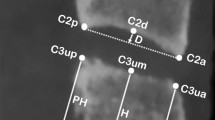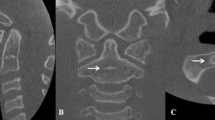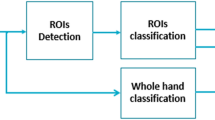Abstract
Purpose
Nowadays, the integration of Artificial intelligence algorithms and quantified radiographic imaging-based diagnostic procedures is hailing amplified deliberation particularly in assessment of skeletal maturity. So we intend to formulate a logistic regression model for intelligent and quantitative estimation of Fishman skeletal maturation index (SMI) based on the parameters attained from the cervical vertebrae CBCT images of Chinese girls.
Methods
From 709 hand wrist radiographs and CBCT images, 447 samples were randomly selected (called as G1) to build a logistic regression model. The reliability and reproducibility were assessed by the intraclass correlation coefficient (ICC) and weighted Cohen’s kappa, followed by Spearman’s rank correlation coefficient to identify the parameters significantly associated with the SMI. Two hundred and sixty-two other subjects (named G2) were recruited for external examination of the models by direct visual comparison and the receiver operating characteristic (ROC) curve. In cases of confusion and mispredictions, the model was modified to improve the consistency.
Results
Five significant parameters (Chronological age, C3 height (H3)\()\), C4 upper width (UW4), C4 lower width (LW4), and the ratio of posterior height to lower width of C4 (\(\mathrm{PH}4/\mathrm{LW}4)\)) were administered into logistic regression model. Despite total agreement percentage which was 84% (total AUC = 0.92), unsatisfactory performance was noticed for the 6th and 8th stages which were confused with their neighboring stages. After adjustments of the models, the total agreement percentage and AUC were upgraded to 88% and 0.96, respectively.
Conclusion
Consistency and fitness evaluation of our models demonstrated adequate prediction percentage and reliability for automated classification of skeletal maturation. The presented constructed logistic regression model has the potential to serve as a maturity evaluation index in clinical craniofacial orthopedics in Chinese girls. The proposed model in this study showed promising strength for being expended in the event of other clinical multi-stage conditions.






Similar content being viewed by others
Availability of data and material
The data that support the findings of this study are available on request from the corresponding author, [BY]. The data are not publicly available due to being currently used in another ongoing research project.
Code availability
Not applicable.
References
Flores-Mir C, Nebbe B, Major PW (2004) Use of skeletal maturation based on hand–wrist radiographic analysis as a predictor of facial growth: a systematic review. Angle Orthod 74:118–124. https://doi.org/10.1043/0003-3219(2004)074%3c0118:UOSMBO%3e2.0.CO;2
Wong RWK, Alkhal HA, Rabie ABM (2009) Use of cervical vertebral maturation to determine skeletal age. Am J Orthod Dentofac Orthop 136:484.e1-484.e6. https://doi.org/10.1016/j.ajodo.2007.08.033
Baccetti T, Franchi L, Toth LR, McNamara JA (2000) Treatment timing for twin-block therapy. Am J Orthod Dentofac Orthop. https://doi.org/10.1067/mod.2000.105571
Arat ZM, Rübendüz M, Akgül AA (2003) The displacement of craniofacial reference landmarks during puberty: a comparison of three superimposition methods. Angle Orthod. https://doi.org/10.1043/0003-3219(2003)073%3c0374:TDOCRL%3e2.0.CO;2
Nanda RS (1955) The rates of growth of several facial components measured from serial cephalometric roentgenograms. Am J Orthod 41:658–673
Hägg U, Taranger J (1982) Maturation indicators and the pubertal growth spurt. Am J Orthod 82:299–309
Lamparski DG (1972) Skeletal age assessment utilizing cervical vertebrae. Master Science thesis, University of Pittsburgh
Greulich W, Pyle S (1959) Radiographic ossification and the adolescent growth spurt. Am J Orthod 69:611–619
Cunha AC, Cevidanes LHS, Sant’Anna EF, Guedes FR, Luiz RR, McNamara JA, Franchi L, Ruellas ACO (2018) Staging hand–wrist and cervical vertebrae images: a comparison of reproducibility. Dentomaxillofacial Radiol 47:20170301. https://doi.org/10.1259/dmfr.20170301
Uysal T, Ramoglu SI, Basciftci FA, Sari Z (2006) Chronologic age and skeletal maturation of the cervical vertebrae and hand–wrist: is there a relationship? Am J Orthod Dentofac Orthop 130:622–628. https://doi.org/10.1016/j.ajodo.2005.01.031
San Román P, Palma JC, Oteo MD, Nevado E (2002) Skeletal maturation determined by cervical vertebrae development. Eur J Orthod 24:303–311. https://doi.org/10.1093/ejo/24.3.303
Kök H, Acilar AM, İzgi MS (2019) Usage and comparison of artificial intelligence algorithms for determination of growth and development by cervical vertebrae stages in orthodontics. Prog Orthod. https://doi.org/10.1186/s40510-019-0295-8
Amasya H, Cesur E, Yıldırım D, Orhan K (2020) Validation of cervical vertebral maturation stages: artificial intelligence vs human observer visual analysis. Am J Orthod Dentofac Orthop 158:e173–e179. https://doi.org/10.1016/j.ajodo.2020.08.014
Dzemidzic V, Sokic E, Tiro A, Nakas E (2015) Computer based assessment of cervical vertebral maturation stages using digital lateral cephalograms. Acta Inform Med 23:364–368. https://doi.org/10.5455/aim.2015.23.364-368
Santiago RC, Cunha AR, Júnior GC, Fernandes N, Campos MJS, Costa LFM, Vitral RWF, Bolognese AM (2014) New software for cervical vertebral geometry assessment and its relationship to skeletal maturation—a pilot study. Dentomaxillofacial Radiol 43:20130238. https://doi.org/10.1259/dmfr.20130238
Tekın A, Cesur Aydın K (2019) Comparative determination of skeletal maturity by hand–wrist radiograph, cephalometric radiograph and cone beam computed tomography. Oral Radiol. https://doi.org/10.1007/s11282-019-00408-y
Echevarría-Sánchez G, Arriola-Guillén LE, Malpartida-Carrillo V, Tinedo-López PL, Palti-Menendez R, Guerrero ME (2020) Reliability of cephalograms derived of cone beam computed tomography versus lateral cephalograms to estimate cervical vertebrae maturity in a Peruvian population: a retrospective study. Int Orthod 18:258–265. https://doi.org/10.1016/j.ortho.2020.01.001
Tadinada A, Schneider S, Yadav S (2018) Role of cone beam computed tomography in contemporary orthodontics. Semin Orthod 24:407–415. https://doi.org/10.1053/j.sodo.2018.10.005
Jain S, Choudhary K, Nagi R, Shukla S, Kaur N, Grover D (2019) New evolution of cone-beam computed tomography in dentistry: combining digital technologies. Imaging Sci Dent 49:179–190. https://doi.org/10.5624/isd.2019.49.3.179
Fasbinder DJ, Dennison JB, Heys D, Neiva G (2008) Practical applications of cone-beam computed tomography in orthodontics. J Am Dent Assoc 141(Suppl):10S-S14. https://doi.org/10.1002/jps.3030451211
Currie G, Hawk KE, Rohren E, Vial A, Klein R (2019) Machine learning and deep learning in medical imaging: intelligent imaging. J Med Imaging Radiat Sci 50:477–487. https://doi.org/10.1016/j.jmir.2019.09.005
Schwendicke F, Samek W, Krois J (2020) Artificial intelligence in dentistry: chances and challenges. J Dent Res 99:769–774. https://doi.org/10.1177/0022034520915714
Dallora AL, Anderberg P, Kvist O, Mendes E, Ruiz SD, Berglund JS (2019) Bone age assessment with various machine learning techniques: a systematic literature review and meta-analysis. PLoS ONE 14:1–22. https://doi.org/10.1371/journal.pone.0220242
Gutierrez PA, Perez-Ortiz M, Sanchez-Monedero J, Fernandez-Navarro F, Hervas-Martinez C (2016) Ordinal regression methods: survey and experimental study. IEEE Trans Knowl Data Eng 28:127–146. https://doi.org/10.1109/TKDE.2015.2457911
Miguel-Hurtado O, Guest R, Stevenage SV, Neil GJ, Black S (2016) Comparing machine learning classifiers and linear/logistic regression to explore the relationship between hand dimensions and demographic characteristics. PLoS ONE 11:e0165521. https://doi.org/10.1371/journal.pone.0165521
Byun BR, Il KY, Yamaguchi T, Maki K, Ko CC, Hwang DS, Park SB, Son WS (2015) Quantitative skeletal maturation estimation using cone-beam computed tomography-generated cervical vertebral images: a pilot study in 5- to 18-year-old Japanese children. Clin Oral Investig 19:2133–2140. https://doi.org/10.1007/s00784-015-1415-6
Byun B-R, Kim Y-I, Yamaguchi T, Maki K, Son W-S (2015) Quantitative assessment of cervical vertebral maturation using cone beam computed tomography in Korean girls. Comput Math Methods Med 2015:405912. https://doi.org/10.1155/2015/405912
Tripepi G, Jager KJ, Dekker FW, Zoccali C (2008) Linear and logistic regression analysis. Kidney Int 73:806–810. https://doi.org/10.1038/sj.ki.5002787
Fishman LS (1982) Radiographic evaluation of skeletal maturation. A clinically oriented method based on hand–wrist films. Angle Orthod 52:88–112. https://doi.org/10.1043/0003-3219(1982)0522.0.CO;2
Swennen GRJ, Schutyser F, Hausamen J-E (2006) Three-dimensional cephalometry: a color atlas and manual. Springer, Berlin
Chen L, Liu J, Xu T, Long X, Lin J (2010) Quantitative skeletal evaluation based on cervical vertebral maturation: a longitudinal study of adolescents with normal occlusion. Int J Oral Maxillofac Surg 39:653–659. https://doi.org/10.1016/j.ijom.2010.03.026
Grilli L, Rampichini C (2014) Encyclopedia of quality of life and well-being research. Springer, Dordrecht
Jaeger B (2006) The method of least squares. In: Handbook of research on informatics in healthcare and biomedicine, pp 181–185. IGI Global
Hashim H, Mansoor H, Mohamed MH (2018) Assessment of skeletal age using hand–wrist radiographs following Bjork system. J Int Soc Prev Community Dent 8:482. https://doi.org/10.4103/jispcd.JISPCD_315_18
Ferrillo M, Curci C, Roccuzzo A, Migliario M, Invernizzi M, de Sire A (2021) Reliability of cervical vertebral maturation compared to hand–wrist for skeletal maturation assessment in growing subjects: a systematic review. J Back Musculoskelet Rehabil. https://doi.org/10.3233/BMR-210003
Szemraj A, Wojtaszek-Słomińska A, Racka-Pilszak B (2018) Is the cervical vertebral maturation (CVM) method effective enough to replace the hand–wrist maturation (HWM) method in determining skeletal maturation?—a systematic review. Eur J Radiol 102:125–128. https://doi.org/10.1016/j.ejrad.2018.03.012
Demirjian A, Buschang PH, Tanguay R, Patterson DK (1985) Interrelationships among measures of somatic, skeletal, dental, and sexual maturity. Am J Orthod 88:433–438. https://doi.org/10.1016/0002-9416(85)90070-3
Fishman LS (1979) Chronological versus skeletal age, an evaluation of craniofacial growth. Angle Orthod 49:181–189. https://doi.org/10.1043/0003-3219(1979)049%3c0181:CVSAAE%3e2.0.CO;2
Morris JM, Park JH (2012) Correlation of dental maturity with skeletal maturity from radiographic assessment: a review. J Clin Pediatr Dent 36:309–314. https://doi.org/10.17796/jcpd.36.3.l403471880013622
Cericato GO, Bittencourt MAV, Paranhos LR (2015) Validity of the assessment method of skeletal maturation by cervical vertebrae: a systematic review and meta-analysis. Dentomaxillofac Radiol. https://doi.org/10.1259/dmfr.20140270
Kang ST, Choi SH, Kim KH, Hwang CJ (2020) Evaluation of cephalometric characteristics and skeletal maturation of the cervical vertebrae and hand–wrist in girls with central precocious puberty. Korean J Orthod 50:181–187. https://doi.org/10.4041/kjod.2020.50.3.181
Santiago RC, Cunha AR, Júnior GC, Fernandes N, Campos MJS, Costa LFM, Vitral RWF, Bolognese AM (2014) New software for cervical vertebral geometry assessment and its relationship to skeletal maturation—a pilot study. Dentomaxillofacial Radiol. https://doi.org/10.1259/dmfr.20130238
Rajkomar A, Dean J, Kohane I (2019) Machine learning in medicine. N Engl J Med 380:1347–1358. https://doi.org/10.1056/nejmra1814259
Shan T, Tay FR, Gu L (2020) Application of artificial intelligence in dentistry. J Dent Res. https://doi.org/10.1177/0022034520969115
Zitnik M, Nguyen F, Wang B, Leskovec J, Goldenberg A, Hoffman MM (2019) Machine learning for integrating data in biology and medicine: principles, practice, and opportunities. Inf Fusion 50:71–91. https://doi.org/10.1016/j.inffus.2018.09.012
Tajmir SH, Lee H, Shailam R, Gale HI, Nguyen JC, Westra SJ, Lim R, Yune S, Gee MS, Do S (2019) Artificial intelligence-assisted interpretation of bone age radiographs improves accuracy and decreases variability. Skeletal Radiol 48:275–283. https://doi.org/10.1007/s00256-018-3033-2
Booz C, Yel I, Wichmann JL, Boettger S, Al Kamali A, Albrecht MH, Martin SS, Lenga L, Huizinga NA, D’Angelo T, Cavallaro M, Vogl TJ, Bodelle B (2020) Artificial intelligence in bone age assessment: accuracy and efficiency of a novel fully automated algorithm compared to the Greulich–Pyle method. Eur Radiol Exp 4:6. https://doi.org/10.1186/s41747-019-0139-9
Amasya H, Yildirim D, Aydogan T, Kemaloglu N, Orhan K (2020) Cervical vertebral maturation assessment on lateral cephalometric radiographs using artificial intelligence: comparison of machine learning classifier models. Dentomaxillofacial Radiol 49:20190441. https://doi.org/10.1259/dmfr.20190441
Mutasa S, Chang PD, Ruzal-Shapiro C, Ayyala R (2018) MABAL: a novel deep-learning architecture for machine-assisted bone age labeling. J Digit Imaging 31:513–519. https://doi.org/10.1007/s10278-018-0053-3
Litjens G, Kooi T, Bejnordi BE, Setio AAA, Ciompi F, Ghafoorian M, van der Laak JAWM, van Ginneken B, Sánchez CI (2017) A survey on deep learning in medical image analysis. Med Image Anal 42:60–88. https://doi.org/10.1016/j.media.2017.07.005
Funding
This study is supported by National Natural Science Foundation of China (Grant no. 82071143 and no. 82101079), Key Medical Research Projects of Jiangsu Health Commission (ZDA2020003), Key R&D program of Jiangsu province (BE2018723), Natural Science Foundation of Jiangsu province (BK20180670), the Priority Academic Program Development of Jiangsu Higher Education Institutions (PAPD, 2018-87).
Author information
Authors and Affiliations
Contributions
LX and WT designed the study and performed the experiments. Data collection and manuscript writing were done by II and WT. ZZ and YZ carried out statistical analysis and interpretation of the results. HL and BY conceived and supervised the whole project. All authors read and approved the final manuscript.
Corresponding author
Ethics declarations
Conflicts of interest
The authors declare no potential conflicts of interest with respect to the content, authorship and/or publication of this article.
Ethics approval
This study was approved by the Institutional ethical committee of Nanjing Medical University (No. PJ2017-045-001).
Consent to participate
Written informed consent for utilization of scans in future research projects was obtained from all individuals, their parents or legal tutors prior to taking all the 709 images.
Consent for publication
All the authors certify that human research participants provided informed consent for publication of their data and radiographic images in Figs. 2 and 3.
Additional information
Publisher's Note
Springer Nature remains neutral with regard to jurisdictional claims in published maps and institutional affiliations.
Rights and permissions
About this article
Cite this article
Xie, L., Tang, W., Izadikhah, I. et al. Development of a multi-stage model for intelligent and quantitative appraising of skeletal maturity using cervical vertebras cone-beam CT images of Chinese girls. Int J CARS 17, 761–773 (2022). https://doi.org/10.1007/s11548-021-02550-7
Received:
Accepted:
Published:
Issue Date:
DOI: https://doi.org/10.1007/s11548-021-02550-7




